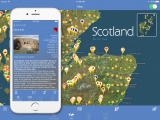<< Text Pages >> Chilonche - Ancient Village or Settlement in Guatemala
Submitted by coldrum on Thursday, 25 February 2010 Page Views: 7275
Multi-periodSite Name: ChiloncheCountry: Guatemala
NOTE: This site is 26.989 km away from the location you searched for.
Type: Ancient Village or Settlement
Latitude: 16.812444N Longitude: 89.561694W
Condition:
| 5 | Perfect |
| 4 | Almost Perfect |
| 3 | Reasonable but with some damage |
| 2 | Ruined but still recognisable as an ancient site |
| 1 | Pretty much destroyed, possibly visible as crop marks |
| 0 | No data. |
| -1 | Completely destroyed |
| 5 | Superb |
| 4 | Good |
| 3 | Ordinary |
| 2 | Not Good |
| 1 | Awful |
| 0 | No data. |
| 5 | Can be driven to, probably with disabled access |
| 4 | Short walk on a footpath |
| 3 | Requiring a bit more of a walk |
| 2 | A long walk |
| 1 | In the middle of nowhere, a nightmare to find |
| 0 | No data. |
| 5 | co-ordinates taken by GPS or official recorded co-ordinates |
| 4 | co-ordinates scaled from a detailed map |
| 3 | co-ordinates scaled from a bad map |
| 2 | co-ordinates of the nearest village |
| 1 | co-ordinates of the nearest town |
| 0 | no data |
Be the first person to rate this site - see the 'Contribute!' box in the right hand menu.
Internal Links:
External Links:
Ancient Settlement in Peten, Guatemala. Archaeologists have discovered a huge Mayan sculptured head in Guatemala that suggests a little-known site in the jungle-covered Peten region may once have been a significant city.
The stucco sculpture, which is more than three metres wide by four metres high, was buried for centuries at the Chilonche ruins, close to the border with Belize.
The recent discovery of the head, which dates from the early Classic period between 300 to 600 AD, means the site is much older than previously thought. The Maya often constructed new buildings using older ones as foundations.
"It could be an imaginary being, something from the underworld, perhaps linked to a Mayan deity," Polytechnic University of Valencia professor Gaspar Munoz, part of the team of archaeologists that found the head, said.
Unlike Guatemala's famous Mayan cities of Tikal and El Mirador, little excavation has been carried out at Chilonche.
Looters, looking for artifacts to sell on the black market, had dug a small tunnel passing the buried sculpture, which is similar to others decorating a solar observatory at another site, Uaxactun. Guatemala's Peten region is home to dozens of Mayan ruins, but the largely jungle-covered area is plagued by looters, poachers and smugglers taking cocaine to Mexico.
Note: location given is general to a group of Mayan cities in Peten. Chilonche is described as being near Naranjo, Nakum, and Tikal.
Read More, and a photo at The Herald Sun.
Note: Find at Mayan Center Leads to book on Mayan Pictographs.
You may be viewing yesterday's version of this page. To see the most up to date information please register for a free account.
Do not use the above information on other web sites or publications without permission of the contributor.
Click here to see more info for this site
Nearby sites
Click here to view sites on an interactive map of the areaKey: Red: member's photo, Blue: 3rd party photo, Yellow: other image, Green: no photo - please go there and take one, Grey: site destroyed
Download sites to:
KML (Google Earth)
GPX (GPS waypoints)
CSV (Garmin/Navman)
CSV (Excel)
To unlock full downloads you need to sign up as a Contributory Member. Otherwise downloads are limited to 50 sites.
Turn off the page maps and other distractions
Nearby sites listing. In the following links * = Image available
22.2km NW 323° Ixlú Ancient Village or Settlement
23.1km NE 39° Holtun* Ancient Village or Settlement
33.5km NNE 31° Yaxha* Ancient Village or Settlement
37.5km WNW 290° Nojpetén* Ancient Village or Settlement
42.3km WNW 291° Nixtun-Ch'ich' Ancient Village or Settlement
43.7km NNE 22° Nakum* Ancient Village or Settlement
46.3km N 351° Tikal* Ancient Village or Settlement
47.6km E 96° Caracol Ancient Village or Settlement
47.8km NE 42° Naranjo* Ancient Village or Settlement
54.3km NE 55° Xunantunich* Ancient Village or Settlement
58.1km NNW 335° El Zotz* Ancient Village or Settlement
61.5km ENE 57° Chaa Creek* Ancient Village or Settlement
62.8km WSW 238° Ceibal* Ancient Village or Settlement
63.4km NNE 29° Holmul Ancient Village or Settlement
63.8km NE 54° Cahal Pech Ancient Village or Settlement
65.1km N 353° Uaxactun* Ancient Village or Settlement
66.2km NE 42° El Pilar* Ancient Village or Settlement
69.5km NNE 29° Cival Ancient Village or Settlement
82.7km SW 236° Aguateca* Ancient Village or Settlement
82.8km NNE 18° Xultun Ancient Village or Settlement
83.5km NNE 12° San Bartolo* Ancient Village or Settlement
85.1km ESE 111° Quebrada de Oro Ancient Village or Settlement
87.2km SE 132° Lubaantun* Ancient Village or Settlement
88.2km WSW 243° Dos Pilas* Ancient Village or Settlement
90.7km NNW 328° La Florida* Ancient Village or Settlement
View more nearby sites and additional images






 We would like to know more about this location. Please feel free to add a brief description and any relevant information in your own language.
We would like to know more about this location. Please feel free to add a brief description and any relevant information in your own language. Wir möchten mehr über diese Stätte erfahren. Bitte zögern Sie nicht, eine kurze Beschreibung und relevante Informationen in Deutsch hinzuzufügen.
Wir möchten mehr über diese Stätte erfahren. Bitte zögern Sie nicht, eine kurze Beschreibung und relevante Informationen in Deutsch hinzuzufügen. Nous aimerions en savoir encore un peu sur les lieux. S'il vous plaît n'hesitez pas à ajouter une courte description et tous les renseignements pertinents dans votre propre langue.
Nous aimerions en savoir encore un peu sur les lieux. S'il vous plaît n'hesitez pas à ajouter une courte description et tous les renseignements pertinents dans votre propre langue. Quisieramos informarnos un poco más de las lugares. No dude en añadir una breve descripción y otros datos relevantes en su propio idioma.
Quisieramos informarnos un poco más de las lugares. No dude en añadir una breve descripción y otros datos relevantes en su propio idioma.